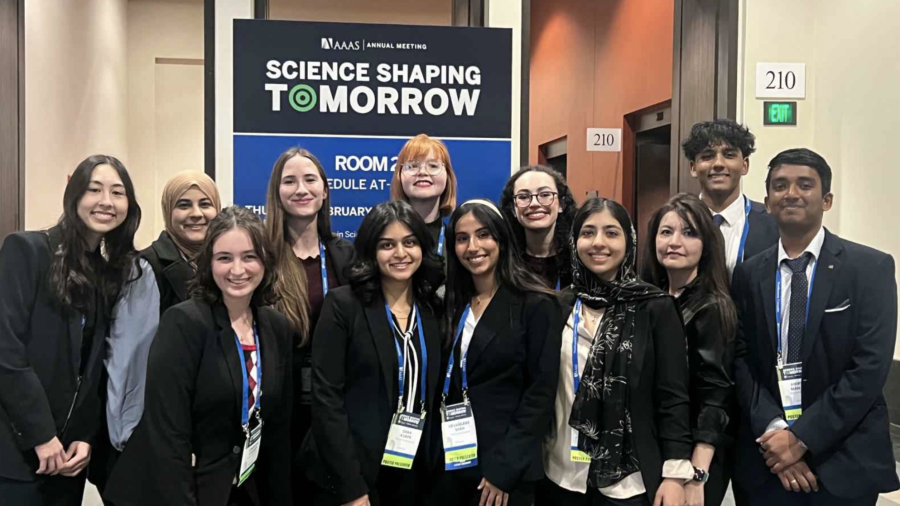ASU Students Share Experiences from AAAS 2025 Annual Meeting

ASU students posing for a photo in front of a sign for the AAAS 2025 Annual Meeting. Student names as pictured from left to right: Aubrey Pinteric, Tasneem Mohammed, Christina Stewart, Ava Claus, Sara Korpe, Jynx Pigart, Devagana Shah, Sarah Nesbit, Fathima Nawaz, Akaash Surendra, Anirudh Manjesh.
A group of 12 Arizona State University students traveled to Boston, Massachusetts, in February for the annual meeting of the American Association for the Advancement of Science (AAAS), one of the largest general science conferences in the world. Each year, the Center for Biology and Society and Barrett, The Honors College, co-sponsor ASU students to attend the AAAS conference and compete in the meeting’s poster competition.
“Attending the AAAS 2025 Annual Meeting was an incredible opportunity to share my research and connect with other scholars,” says Ava Claus, an undergraduate honors student who presented a poster in the Environment and Ecology category, focusing on her research investigating ground beetle diversity over time. Ava also shared that this was an amazing opportunity to highlight her work bringing attention to the monitoring and conservation of overlooked organisms to a national audience.
For the contest, each student gave a three-minute presentation on a poster they designed to communicate their research to a panel of up to six content-expert judges. The cohort, including three graduate students and nine undergraduates from across ASU’s campuses, covered a wide range of topics. These topics included understanding the relationship between macrophages and lung cancer, how curiosity and prosocial behavior develop in children, and X-chromosome inactivation.
ASU presenters highlighted how attending AAAS provided an immersive experience for their scientific identity. Anirudh Manjesh, an undergraduate honors student who presented in the Brain and Behavior category, shared, “It was inspiring to engage with scientists from diverse fields, exchange ideas, and learn about groundbreaking discoveries.” Although Manjesh presented his research examining the sleeping habits of honeybees, he is a computer science major at ASU using animal models to inform the development of artificial neural networks—a foundational component of machine learning that can mimic sleep processes and enhance memory consolidation in AI systems. Manjesh’s highly interdisciplinary expertise represents many students from Barrett, The Honors College.
“This experience expanded my network and strengthened my vision for where I want my research to go next,” said Aida Movahed, a second-year PhD student in the Center for Biology and Society who examines the use of lab-grown brain models, called cerebral organoids, as a new avenue for researching neurodegenerative disease. Movahed presented her poster on cerebral organoids and described participating in the poster competition as “a rewarding opportunity to share my work with a broader scientific community and receive insightful feedback from researchers across disciplines.” Movahed hopes to explore cerebral organoid research's ethical, scientific, and translational implications as she develops her dissertation.
Other students found presenting at AAAS highly encouraging for their research. “Attending AAAS instilled in me further passion and motivation for conducting scientific research,” said Tasneem Mohammed, a third-year PhD candidate from the Center for Biology and Society, who presented her research on the impact of academia on science faculty with depression. Mohammed won first place for graduate student presenters in the Science and Society category.
Jane Maienschein and Jessica Ranney, the founding and assistant directors of the Center for Biology and Society, along with Georgette Briggs, an Honors Faculty Fellow at Barrett, helped students prepare and practice their posters.
The support and mentoring efforts were successful in more than one way. Similarly, Aubrey Pinteric won first place in the Science and Society category as an undergraduate student for her poster on uterine technologies and their social implications from the past to the future. The opportunity to present research at a national conference like the 2025 AAAS Annual Meeting also solidified Pinteric’s goal to enter a full-time research position upon graduation: “The conference affirmed my interest in continuing my involvement in research.” Pinteric is working towards an eventual career as a primary care physician at a research medical center.
The winners of the AAAS e-poster competition will appear in an April issue of Science magazine.
Note: This story was originally published on the website for the Center for Biology and Society.